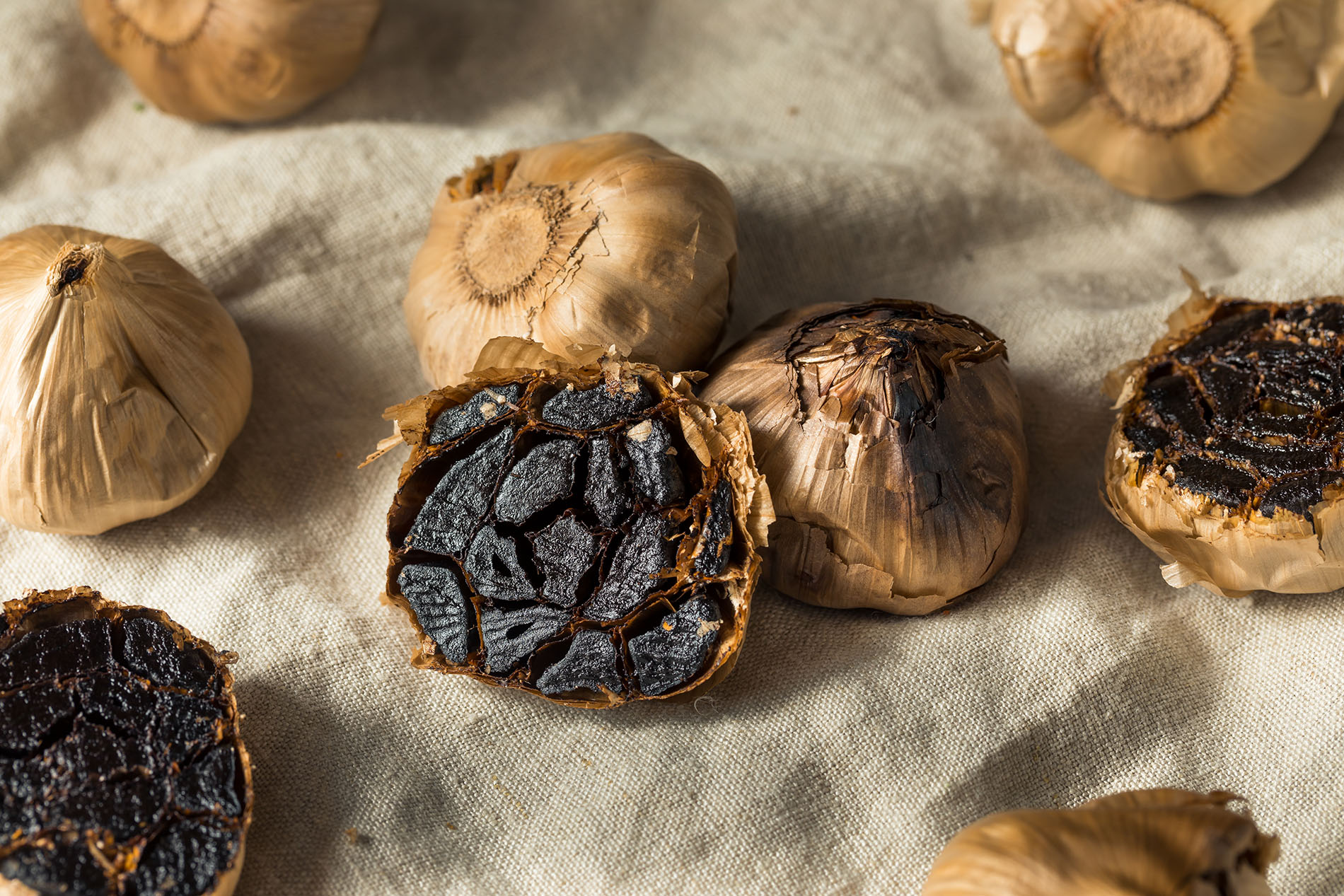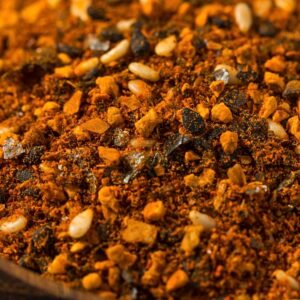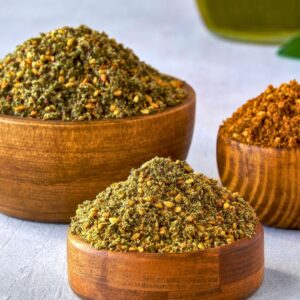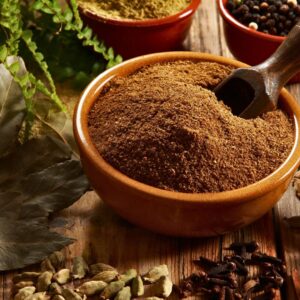Written by: Amanda Csolak for Spice Station Silverlake
It doesn’t smell like normal garlic, and it surely doesn’t look like it, either. Black garlic is truly different than the fresh, white kind you’re used to. With its savory and sweet flavors, black garlic is unmatchable. In this article, we will highlight the history behind black garlic, its surprising health benefits, and how you can use it in your kitchen. I’ll even tell you where to find it! Read on to learn all about black garlic.
White Garlic Vs. Black Garlic
Some recipes may offer substitutions like roasted garlic, but black garlic stands out from the crowd. The fact is, black garlic is vastly different than roasted garlic, and if you were to switch the two, you’d find your recipe doesn’t taste quite the same.
You may be wondering, what is black garlic? We’ve all heard of regular white garlic, its funny-looking bulbs that turn some of the most boring dishes into unforgettable, savory meals with a potent smell enjoyed by garlic lovers everywhere. But it’s not the same as black garlic.
If you’re lucky, you may have seen black garlic at your local farmers’ market stand, but this unusual spice is not commonly found in grocery stores. I’ll tell you where you can find it a little later on. But for now, let’s discuss the history behind this unique and savory spice that will give new life to your entrees.
The History Behind Black Garlic
The origins of black garlic can be traced to Korea and go back thousands of years. In fact, there are recipes dating back 4,000 years. Making black garlic consists of a lot of heat and a lot of time. When fresh garlic is aged in high humidity at around 140 to 185 degrees for an extended length of time, often between 40 and 90 days, the initially fresh, white garlic becomes something new.
Black garlic has a different flavor than white garlic. The pungent odor and spicy taste disappear and are replaced with a non-fragrant, but sweet and savory flavor profile. Described by chefs as tasting sweet and slightly nutty, with hints of molasses, black garlic may have been around for thousands of years, but its relatively new in American shops and kitchens.
Not until 2005 did black garlic make its way to the U.S. culinary world. It was first seen used in an Iron Chef episode, and in 2007, South Korean inventor, Scott Kim, started distributing black garlic he made using his creation, an oven big enough to produce large batches of black garlic, to America. Providing enough black garlic to supply the USA market.
How Does Black Garlic Get It’s Color?
The short answer is heat. Heat is what causes the fresh, white garlic you are familiar with to turn into the sweet and savory black garlic. The heat causes the amino acids and carbohydrates found in garlic to decompose. When these two break down they turn into melanonids. This process is known as the Maillard reaction. These melanonids are compounds responsible for giving the garlic it’s brown or black color.
These compounds are full of glucose and fructose, which is why black garlic tastes like molasses. Antioxidants such as polyphenols and flavonoids help to change not just the taste of black garlic, but they also affect black garlic’s overall texture and appearance.
The chemical compounds that help make black garlic what it is also bring some increased health benefits not found in regular, white garlic. Below, we will discuss what the health benefits this superfood holds. A secret the Eastern world of medicine has known about for a millennia.
Health Benefits of Black Garlic
Black garlic has some pretty awesome qualities. From helping keep the heart healthy, to controlling blood sugar and reducing inflammation, black garlic is a pretty powerful herb. In countries like Korea and Japan, black garlic has long been used for its medicinal properties. With origins as a health food supplement, black garlic contains twice the amount of antioxidants and vitamin C as fresh, white garlic. During the Maillard reaction, it also develops high concentrations of Sulphur, a highly beneficial chemical element. It also contains four times the amount of protein (12.3g Vs. white garlic’s 3.3g), polyphenols, and 5.83 grams of S-Allyl cysteine or SAC, a naturally occurring compound that fights cancer.
It’s no surprise the Japanese believe it has longevity powers. With all the powerful antioxidants within these little black bulbs, they are great for the immune system, helping to boost your bodies natural defenses against germs and viruses.
Cooking With Black Garlic
Black garlic can be enjoyed as-is, served on toast, or used in sauces, soups, or marinades. It can even be used as a gourmet pizza topping or simply tossed into any vegetable side dish, giving the dish a unique savory flavor that will take your meals to the next level.
Unlike fresh, white garlic, black garlic has a rather subtle, delicate flavor profile. If you’re looking to achieve the same intensity you would get from using fresh, white garlic then you can plan to use a larger quantity of black garlic. But if you have a recipe calling for garlic, do not substitute black garlic in its place. The two have very different flavors and therefore are not interchangeable.
One easy way to use black garlic in cooking is by pureeing the bulbs in a small amount of a neutral-tasting oil, like canola oil. This mixture can be used in any recipe and can be refrigerated for later use. This garlic oil paste may also be used to give flavor to foods that are typically bland such as mashed potatoes and stews.
However, keep in mind that the flavor’s of black garlic are subtle, therefore its flavor can be overpowered by other ingredients. So don’t be surprised if you need to add more black garlic to that recipe than you would if you were using raw, white garlic. But all that black garlic is going to be so worth it! If you love white garlic like I do, you’ll love black garlic even more.
Where to Buy Black Garlic
It may be hard to find in your local grocery store or farmer’s market stand, but black garlic is easy to find at Spice Station Silverlake. My personal favorite place to shop for all my spice needs, Spice Station Silverlake has everything you need! It’s not just where I find the best black garlic around. From Ceylon Cinnamon (true Cinnamon) to Dried Ghost Peppers, and many varieties of black peppers, salts and sugars from around the world. Spice Station Silverlake bring the spices of the world to your doorstep.
Steak Frites with Savory Black Garlic Butter
A French meal consisting of tender, juicy steak served with crispy fries enhanced with the unique flavors of the black garlic butter will have you adding this recipe to your favorites list.
Total Time: 1 hour and 5 minutes
Yields: 4 servings
Equipment You’ll Need: a small mixing bowl, a fork, parchment paper, a deep dutch oven or deep fryer, a skillet or grill.
Ingredients:
- 1/4 cup unsalted butter, softened
- 1 teaspoon brandy
- 1/2 teaspoons Black Garlic Salt,
- 2 ¼ tsp Kosher Pacific Blue Flake Salt, divided, plus more for sprinkling
- 2 pounds russet potatoes, sliced into 1/4-inch-thick strands
- 1 tablespoon peanut or grapeseed oil, plus more for frying
- 1 1/2 pounds trimmed grass-fed hanger steaks (2 to 3 steaks)
- 1 teaspoon cracked Kampot Black Peppercorns
- Finely chopped fresh flat-leaf parsley, for garnish (optional)
Instructions:
- Place softened butter, brandy, and 1/4 teaspoon black garlic salt; mix until thoroughly combined. Spoon black garlic butter mixture onto a sheet of parchment paper or plastic wrap, and roll into a 3-inch-long log. Refrigerate until ready to use.
- Mound sliced potatoes on a large microwavable plate or in a glass pie plate; cover with wet paper towels. Microwave on high until tender, 4 to 6 minutes. Spread in an even layer on a rimmed baking sheet, and let cool 10 minutes.
- Pour peanut oil to a depth of 1 1/2 inches in a large, deep Dutch oven; heat over medium to 375°F. (The hot oil will rise when potatoes are added.)
- Meanwhile, heat 1 tablespoon peanut oil in a 12-inch skillet over medium-high. Pat steaks dry with paper towels; sprinkle with pepper and remaining 2 teaspoons salt. Add steaks to skillet, and cook, turning every 3 minutes to evenly brown all sides, to desired degree of doneness, about 12 minutes for medium-rare. Transfer steaks to a carving board, and let rest 10 minutes.
- Meanwhile, fry potatoes in hot oil in 2 to 3 batches, stirring often with a spider or slotted spoon, until frites are golden and crisp, 4 to 6 minutes. (Adjust heat between batches as needed to maintain oil temperature of 375°F.) Transfer frites to a butcher paper–lined plate. Sprinkle with salt.
- Cut steaks against the grain into slices; divide among 4 plates. Cut black garlic butter into 1/2-inch-thick rounds. Top steak with black garlic butter, and, if desired, parsley. Serve immediately with frites.
Chef’s Notes:
- Black garlic butter can be made ahead of time up to 3 days if kept in the refrigerator or up to one month in the freezer.











